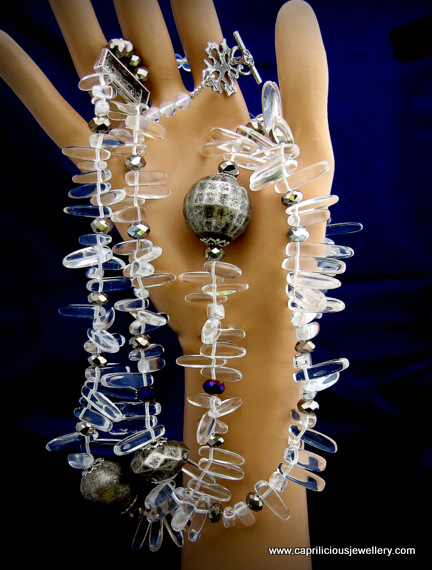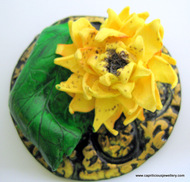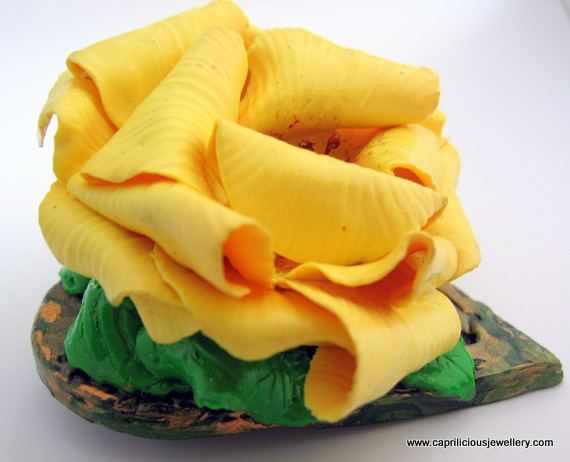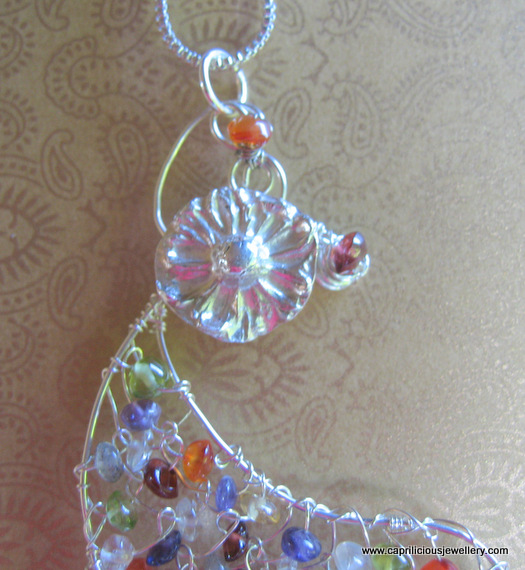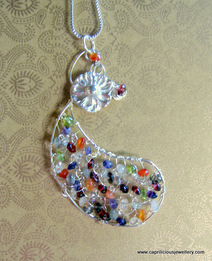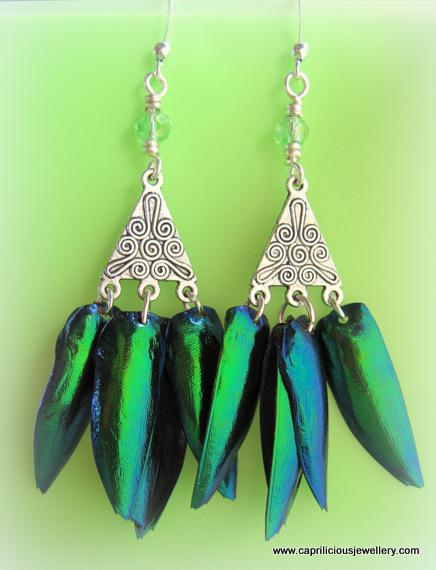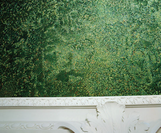|
Beautiful Handmade Statement Necklaces and other Fabulousness from Neena Shilvock - Inspirations and Designs From the Week Gone by
Good day everyone, I trust you had a good week. I have been very rested, as I took some time off the day job, and found I had no pressing matters to attend to, so could chill, and make as many pieces of jewellery as I like, with little or no interruption. This week, I tried out a new technique - chainmaille. Chainmaille is the practice of linking rings to create interesting patterns, or more traditionally "sheets" of flexible metal for the purpose of armor or decoration. The name comes from the French word maille, derived from the Latin macula, which means a 'mesh of net'. The basic weaves use jump rings, which are open rings not intended to be soldered. For decorative use, the supportive structure of the weaves is enough to ensure the rings don't pull open. I bought a rhodochrosite carved pendant a while ago - rhodochrosite is a reddish pink stone - the pink color of rhodochrosite is caused by the element manganese and it is formed when manganese is dissolved by ground water and combines with a carbonate material, then drips off the ceiling of caves and crevices deep underground. It is commonly found in the form of stalactites and stalagmites in the caves of Argentina. The Incas, who called it Inca Rose, believed that rhodochrosite is the blood of their former kings and queens that was turned to stone. I am by no stretch of imagination a 'pink lady' - but I had to have the pendant - the carving called out to me - 'buy me Neena, buy me' it implored. I searched for a suitable way to tone down the pinkness - I bought Morganite - too pink, tektite - too black, rose quartz - even more 'too pink', and finally, after my bead stash was swollen with unsuitable (!) elements, I found frosted red agate - orangey pink/ red beads, smudged with inky black, and frosted over like the bloom on a grape - lovely! The Mermaid's Song This necklace just grrrrrew - couldnt stop it - I made a seahorse, a couple of starfish, and a 'fisherman's net' around the mermaid with fish and other shells caught up in it - and then thought I would try the chainmaille techniques out here to link the beads together - well, easier said than done - it is ever such a fiddly technique, and certainly not suited to sitting in front of the telly with a tray in your lap. But, I persevered and in the end, I am glad I did. Love knots are very basic chain maille links, with three rings linked together, rather like a Russian wedding ring, and the individual bead links leading off the centre of the knot. All was well till I decided I didn't like the placement of one or two of the elements - it has to be just so for me - and for you - and everything needed to be taken apart and redone - but in the end, I liked the effect - a little more ornate than using just the one ring between elements, I may try this again, and who knows, one day, I might surprise myself with a bracelet made of chainmaille links (don't hold your breath, Neena!). Diamond White Diamond White is a necklace made of clear quartz needles with pewter coloured vintage focal beads from another necklace I cannibalised. It is also a cider with a hight alcohol content (12.5%) here in the UK and it had a certain following amongst my friends when I was young. I decided that I would use the name of an old favourite for this rather nice necklace. One of my friends said it made her think of winter - but hey, our non summer is almost over - and we have to face a bleak winter - what better way than to wear nice jewellery - wearing pretty stuff puts a smile on my face, anyway. Here Comes The Sun Confused?? - the weather here certainly is - one day it is hot and sunny, and the next it is raining cats and dogs and freezing cold - my jewellery efforts reflect that seesaw - so on this particular day, after a swim and a barbeque meal (no clearing up - yippee!), I sat down with a reel of copper wire and some peridot beads and made this..... I love the green of peridot - wish it wasn't quite so expensive - but in common with amethysts and aquamarine, it is too expensive to buy in large amounts. Peridot is one of the few gemstones that occur in only one color, an olive green. The intensity and tint of the green comes from the iron in the crystal structure. It is also called Olivine - due to its colour, and is classed as a precious gem. I got the faceted teardrops on a visit to Capri, where they seem to have large deposits of the gemstone, and I used two of them in these copper wire earrings. And while the barbeque was sizzling and Mike was slaving away over it, I put the polymer clay flowers I made a few weeks ago onto brooch backs and popped them in the oven to cure. The Paisley pattern has been around for simply ages - its origins are claimed by the peoples of both India and Persia, but its Western name derives from the Scottish town of Paisley. In India, it is a common design, and thought to be a stylised mango. It was popularised in the Western world by the East India Company, and adopted by Liberty into the 'Liberty Print'. I am very familiar with this design, as it is very common in the gold thread work in South India, where I am from, originally, so I decided to make a paisley 'mango' in silver, with some delicious multicoloured tourmaline I acquired earlier, and add a fine silver daisy made from Precious Metal Clay in my kiln. I used wire netting to fill out the paisley shape with tourmaline beads, and hung it from the daisy on a silver chain - sweet! The Wings of Love A Hungarian jewellery maker I once bought a bracelet from posted a piece of embroidered jewellery she created around a beetle's wing - I was startled and thought then that she was joking, but not so - the naturally beautiful elytra (wings) of the Green Jewel beetle (Sternocera aequisignata) shift in color from green to hints of blue at the edges, and the surface is shiny and iridescent, giving the effect of sunlight on an oil-slick. The beetles have a short life span of 3-4 days, and when they die, they loose their wings, which are then collected up for use in various objects, and jewellery. No beetles are harmed in the making of this jewellery (phew!). A bit more research revealed that beetle wings have been used for centuries by Indian civilizations, cut into tiny spangle shapes and sequins to adorn a range of objects, their reflective properties admired as a means to ward off evil spirits. The beetles, in beautiful colours are like living jewels, and in Victorian England it was the height of cool to have live jewel beetles tethered by tiny gold chains to your décolletage! The beetles were caged and fed, and covered with gemstones, if they weren't colourful enough, and taken on regular outings pinned to the lady's chest! I set out looking for these wings, and found a vendor in Thailand, where these beetles are found, and am now the proud owner of a large number of these wings, this means that I will need to think up plenty of designs to use all of them, but I have no doubt that they will be liked - anyone who likes shiny, pretty things, is bound to like these. I made some earrings, just to get the feel of this new acquisition - but I just know that they will fly out of my hands real quick! I did worry a little about the word 'beetle' which does not conjure up the nicest image - but hey, if the Victorians could wear real live beetles, why shouldn't we wear the wings, beautiful as they are - just takes a bit of getting used to - and we do wear leather from dead animals all the time, don't we?? A bit more about those Victorians - they loved insect jewellery - apparently. For example, Caddisfly larvae glue together tiny stones, grains of sand, and bits of litter to form cases that camouflage and protect them from their natural enemies. When gold nuggets, shells, or semiprecious stones, were added to their cages, they incorporated these into their protective cases, which was later harvested and made into earrings, necklaces, tie tacks, and pins. Amber jewellery - or fossilised insect jewellery was also very popular, and remains so today. Though light, the wings are quite robust. I accidentally stood on one and it didn't break (and I am no featherweight)! I will of course provide stoppers, as the earrings are very light - but the converse of that is that they can be made long as you like, without fearing for your earlobes! They make a pleasant swishing sound when they knock against each other - a sort of rustle - brings to mind long silk gowns - which is just the right mental image for these beautiful jewel coloured earrings. The Flemish artist Jan Fabre created the ‘Heaven of Delight’ using 1.6 million of these wings! Fabre and his team of thirty people took 4 months to glue all of the beetle shells to the ceiling and a chandelier in the Heaven of Delight Hall of Mirrors, of the Royal Palace in Brussels. I would have associated the colours and the name with a more exotic place than Brussels, but Fabre really loved these beetle wings and used them extensively in a lot of his art. I hope you have enjoyed the tale of the beetles - I really got stuck into my research about them, and found so much to talk about. The wings are truly beautiful, and I am surprised that they are not more commonly used in jewellery. I must mention Agi Kiss from Moonsafari Beads who set me off on this journey - you can see her piece here - http://www.etsy.com/shop/MoonsafariBeads
That's all for now folks. Catch you later xx
1 Comment
agi kiss
2/9/2012 09:54:02 am
Hey Neena, the earrings are beautiful! I have a pair like those myself, the wings look so amazing :)) But as you wrote, my friends think it is a bit strange, if not disgusting to make jewelry from beetles, even my dad told me so - I was surprised as he works with animals and knows all kinds of creatures, and also a hoarder who collects all kinds of things to make pretty or useful things of them. But whatever, they are beautiful to me! :) The decoration of the palace looks amazing too, i'd like to see it in person, those colors cannot be captured on photos.
Reply
Your comment will be posted after it is approved.
Leave a Reply. |
Follow
|











